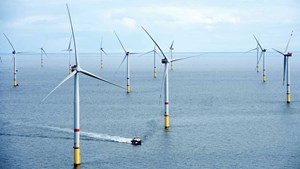(Bloomberg) – Equinor ASA Chairman Jon Erik Reinhardsen said the company has an “open mind” about the structure of its partnership with Danish wind developer Orsted A/S, including the possibility of combining their renewable assets.

“It’s one of many options,” Reinhardsen said on Wednesday, when asked if it would make sense to combine the two companies’ wind assets.
“We will always consider what’s optimum for our shareholders in terms of what structure is best suited here,” he said in an interview on the sidelines of the Pareto Securities energy conference in Oslo. “In what form that ends up being, we have an open mind.”
Orsted shares rose as much as 8.6%, before erasing most of those gains in Copenhagen trading. The stock is down 37% this year. Equinor was little changed.
Equinor said earlier this month that it plans to maintain its 10% stake in Orsted by subscribing for as much as 6 billion Danish kroner ($940 million) of new shares. The commitment came despite the value of its investment plunging after the Trump administration ordered a halt to the construction of Orsted’s Revolution Wind farm, a $6.3 billion project off the coast of Rhode Island that was close to completion.
See more: Future of Orsted’s wind farm in discussions, says U.S. energy chief
U.S. President Donald Trump has issued a series of orders designed to throttle the nascent offshore wind industry. Equinor’s Empire Wind farm off the coast of Long Island was among the projects targeted, though a flurry of negotiations resulted in work resuming.
“We are basically in the first real crisis of the offshore wind industry, with a strong inflation, regulatory challenges and, not least, what we’ve seen in the US lately,” Reinhardsen said. “But underlying, we are strong believers in offshore wind and the place it has in the overall energy supply.”
Last year, there were preliminary talks between representatives of Orsted and Equinor about the possibility of a merger. Those talks were abandoned, but Norway’s biggest oil and gas producer said earlier this month that a “closer industrial and strategic collaboration” between the two companies can create value for all of their shareholders.
Combining the firms’ offshore wind assets could allow them to “diversify portfolios, share capital burdens and refocus on Europe,” Bloomberg Industry analyst Patricio Alvarez and Joao Martins said in a note.
“We need size in this industry just as we have seen it in the oil and gas industry, it’s how the super majors were formed,” Reinhardsen said. “We have to build stronger alliances here that can tackle this market.”
In spite of recent challenges, the sector is well placed for future growth, the chairman said, noting that wind power may be a viable solution for large cities with infrastructure constraints.
“We have our own skills, but we need to scale up together with others and that’s part of the thinking around Orsted,” Reinhardsen said.
Read next: Equinor cuts renewables target, forecasts growth for oil and gas

